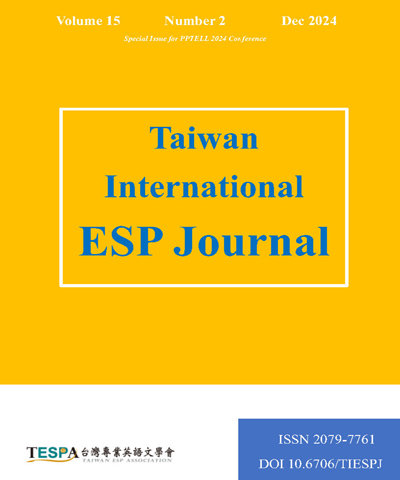
Taiwan International ESP Journal/台灣專業英語文期刊
- OpenAccess
台灣專業英語文學會,正常發行
選擇卷期
- 期刊
- OpenAccess
Enclosed in a steady cloud-stored environment featuring blended learning strategies, and facilitating effective participation by teachers and students, Google Classroom, a learning management system (LMS), has developed into a mature teaching console for administering educational courses, enhancing learning effects, and leveraging online teaching resources. Employing Google Classroom as a pedagogical tool and applying the concept of Needs Analysis, this study implemented gamified learning in a college EFL writing course to assess how students' acceptance of the technology and their flow state experiences using it related to its learning efficacy. The findings of the analysis were as follows: (1) perceived ease of use and flow antecedents significantly strengthened learners' perceived usefulness and attitudes regarding the use of Google Classroom as an LMS and learning tool; (2) while the four flow antecedents had no significant influence on future use intentions, the flow indicators did (it was assumed that although the students enjoyed the game elements and convenience of the technology, the design structure of the instruction had the most substantial impact on their intentions to continue using the technology application for language learning in the future); and (3) Google Classroom reduced the anxiety of face-to-face discussion and enhanced the students' self-learning efficacy in EAP writing by facilitating real-time interactive communication between teachers and students. Students' needs in learning writing should be considered throughout game-based learning. The final section of this study offers some thoughts about the future pedagogical applications of Google Classroom.
- 期刊
- OpenAccess
This study examined the types and functions of if-conditionals in lecture introductions. The data comprise 144 if-conditionals from a 37,373-word corpus (3.85 per 1000 words). A majority of if-conditionals are direct conditionals (89.6%), with 10.4% of indirect conditionals. Of the direct conditionals, 72.9% are expressed as open condition and 16.7% as hypothetical condition. Hypothetical if-conditionals are mainly for hedging about the students' knowledge, and less frequently for hedging about the lecturer's own knowledge, hedging the intended interpretation of the utterance, expressing politeness, or making indirect requests. Most of the if-conditional clauses are in an initial position (88.9%), with some in medial (1.4%) and end (9.7%) positions. Initial if-conditional clauses mainly serve as a framework for subsequent propositions by presenting assumptions, but are minimally used for contrasting, exemplification, and exploring options. Medial if-conditional clauses function as a qualifier. End if-conditional clauses are used to remind students of a prior statement. The study shows that if-conditionals have an important information-linking function, and the functions of if-conditionals are linked to the positioning of if-clauses.
- 期刊
- OpenAccess
Although an overwhelming number of studies have addressed various types of academic and non-academic genres in the literature, further exploration of the genres that distribute knowledge rather than produce it seems to be warranted (Tse & Hyland, 2010). Therefore, the present research was carried out to investigate the generic structure of the genre of academic journal description (JD). We compiled a corpus of 120 JDs from the six disciplines of Applied Linguistics, Law, Psychology (soft-sciences), Chemistry, Physics, and Geology (hard-sciences). We used Hyland and Tse's (2009) framework, to analyze the JDs in terms of their functional moves and constituting steps, the optimal order of the moves, and the main characterizing keywords. The findings revealed that the moves of positioning, standing, and publishing practices were found to be obligatory, and the two moves of audience and quality assurance were found to be optional in both soft- and hard-science JDs. The distribution step was found to be a common obligatory step in soft-science JDs, while the scope step was the only obligatory step in hard-science JDs. Implications for future research are discussed.
- 期刊
- OpenAccess
Amid the COVID-19 pandemic, because of its exclusion from the World Health Organization, Taiwan has been relying on international media to voice itself and partake in the global battle against the fast-spreading disease. Under this premise, this study demonstrates an innovative instructional design for the course titled News English for International Literacy, with the goal to elevate students' motivation and competence to read-watch English news. A learning-centered approach was adopted to replace conventional ESP language-centered model: identifying the starting and endpoints of students' learning journey and the route in between. Accordingly, this action research featured needs assessment, team-teaching with field experts, and two-stage role-play. The course timeline synchronized with the development of pandemic; the training prepared students to interact with multimodal journalistic sources to understand ever-changing global development. Twenty-six college-level participants from four different majors joined the study in the southern Taiwan. The data collection instruments included entry and exit surveys, pre-posttests, focus group interviews, and role-play footages. The results showed that students' frequency of international news reading-viewing increased drastically, while their sense of difficulty dropped significantly. In addition, their international news sources widely diversified. The progresses between the parallel assessments on news knowledge and comprehension and international literacy also indicated significant differences. Students expressed positively about the step-wise instruction, especially the inclusion of field experts, and the contextualized meaning-making in the role-play.

